CANADA PROVINCIAL FLAGS
All Flags shown are various sizes and made of Nylon or Polyester material as indicated.
Official Proportions (Ratio of the relationship of each Flag's width to its length) are noted.
Size |
Material |
Price |
3ft x 5ft |
Polyester |
$30.00 |
27" x 54" |
Heavy-Duty Nylon |
$65.00 |
3ft x 6ft |
Heavy-Duty Nylon |
$100.00 |
|
ALBERTA
|
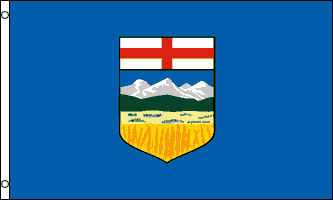 |
|
Proportion: 1:2
History: The Flag was adopted on June 1, 1968 and the coat of arms was adopted in 1907 and modified in 1980. Alberta joined the confederation of Canada on Sept. 1, 1905.
Motto: Fortis et Liber – Strong and Free.
|
Description: The Flag of Alberta consists of a blue base with the shield from the provincial coat of arms in the center. The shield consists of a cross of St. George and below it there is a landscape with mountains, hills, a prairie and a wheat field.
Meaning: The St. George cross signifies Alberta's links to Britain as the cross is the Flag of England. The scene depicts the landscape of the province. |
|
|
|
BRITISH COLUMBIA
|
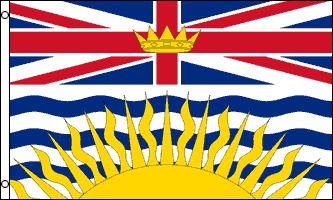 |
|
Proportion: 3:5
History: The Flag was adopted on June 27, 1960. The coat of arms was adopted in 1906 and modified in 1987. British Columbia joined the Confederation of Canada on July 20, 1871.
Motto: Splendor Sine Occasu – Splendor without Diminishment.
|
Description: The top portion of the Flag consists of a British Union Jack with a gold, five pointed crown in its center. The bottom section of the Flag consists of a base of seven alternating blue and white horizontal, wavy stripes with a rising sun with emanating rays. The design is similar to the shield on the province's coat of arms.
Meaning: The blue wavy stripes represent the Pacific Ocean while the sun symbolizes the glory of the province. The sun also signifies the fact that British Columbia is the western most province in Canada. The Union Jack, with the antique golden crown at its centre, represents the Province's British colonial origins.
|
|
|
|
MANITOBA
|
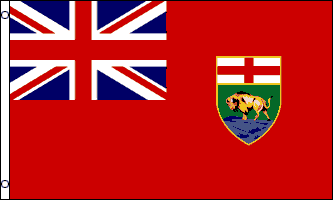 |
|
Proportion: 1:2
History: The Flag was adopted and raised on May 12, 1966. The coat of arms was adopted in 1905 and modified in 1992. Manitoba joined the Confederation of Canada on July 15, 1870.
Motto: Gloriosus et Liber – Glorious and Free
|
Description: The Flag of Manitoba consists of a red base, with a British Union Jack in the top left quarter, with the provincial shield on the right side. The shield features the cross of Saint George and a bison standing on a rock.
Meaning: The Union Jack represents Manitoba's British links and the cross of St. George is a symbol of England. The bison represents the various bison which formerly roamed the province. The name Manitoba comes from the Cree Indian words Manitou bou, which mean narrows of the Great Spirit. The name refers to the point where Lake Manitoba narrows in its centre. |
|
|
|
NEW BRUNSWICK
|
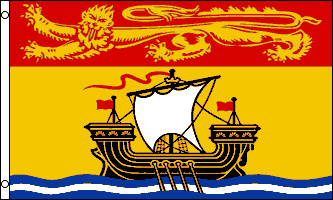 |
|
Proportion: 2.5:4
History: The Flag was adopted on Feb. 24, 1965. The coat of arms was adopted in 1968 and modified in 1984. New Brunswick joined the confederation of Canada on July 1, 1867.
Motto: Spem Reduxit – Hope Restored
|
Description: The Flag of New Brunswick is based on the provincial coat of arms. The top third consists of a golden lion on a red base, with a white sailed ship sailing on the water, on a gold base in the bottom section.
Meaning: The gold lion represents New Brunswick's ties to both the Brunswick region in Germany as well as the coat of arms of the King of England. The ship represents the importance of shipbuilding and seafaring in the province's history. New Brunswick was named, in 1784, in honor of King George III; who was the reigning monarch and also the Duke of Brunswick.
|
|
|
|
NEWFOUNDLAND & LABRADOR
|
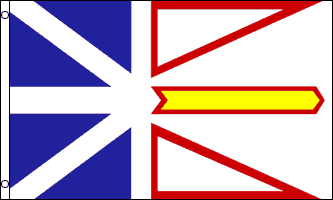 |
|
Proportion: 1:2
History: Act of Legislature assented to May 28, 1980. The Flag was designed by local artist Christopher Pratt. King Henry VII named Newfoundland who referred to John Cabot's discovery in 1497 as the New Found Launde.
Motto: Quaerite Prime Regnum Dei – Seek Ye First the Kingdom of God. |
Description: The Flag of Newfoundland and Labrador consists of blue, gold and red designs on a white base.
Meaning: White = snow and ice, Blue = the sea, Red = human efforts, Gold = confidence in ourselves, Blue section = our Commonwealth heritage (Union Jack) and finally the Red and Gold section = our future. The two triangles outlined in Red show the mainland and island reaching forward together. Golden arrow = pointing to a bright future. But the design of the Flag is symbolic. For example the Christian Cross, the Beothuk and Naskapi ornamentation, the outline of the maple leaf in the centre of the Flag, a triumphant figure and our place in the space age. The image of a trident stands out. This emphasizes the continued dependence on the fishery resources of the sea. Hung as a banner, the arrow assumes the aspect of a sword, which is in remembrance of War Veterans.
|
|
|
|
NORTHWEST TERRITORIES
|
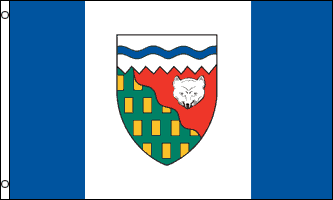 |
|
Proportion: 1:2
History: The Flag was adopted on January 1, 1969. The coat of arms was adopted in 1957. The Northwest Territories joined the Confederation of Canada on July 15, 1870.
Motto: The Northwest Territories has no official motto.
|
Description: The Flag of the Northwest Territories consists of three vertical stripes. The left and right stripes are blue and the middle is white. In the middle of the Flag is the shield from the Territories' coat of arms.
Meaning: The blue stripes represent the lakes and waters of the Territories. The white stripe represents the north's ice and snow. The wavy blue line in the shield represents the Northwest Passage. The gold bars stand for the territory's mineral wealth and the white fox represents the fur industry. Robert Bessant of Margaret, Manitoba designed the Flag. He was the winner of a nationwide competition held in 1968.
|
|
|
|
NOVA SCOTIA
|
 |
|
Proportion: 3:4
History: The Flag was granted by Royal Charter in 1625 and officially adopted in 1929. The coat of arms was adopted in 1625. Nova Scotia joined the Confederation of Canada on July 1, 1867. Royal Warrant of King George V, January 19, 1929 assigning Arms and Banner.
|
Motto: Munit Haec et Altera Vincit - One Defends and the Other Conquers.
Description: The Flag of Nova Scotia consists of a white base with a blue (saltire) cross of St. Andrew on it. In the center of the Flag is the shield from the provincial coat of arms, which is also the coat of arms of Scotland. The arms feature a red lion on a gold base. The Flag is basically a reversal of the Scottish Flag, which is a white saltire on a blue base.
Meaning: The Flag represents Nova Scotia's links to Scotland. The Flag was granted by Royal Charter in 1625 and officially adopted in 1929. The coat of arms was adopted in 1625. Nova Scotia joined the Confederation of Canada on July 1, 1867.
|
|
|
|
NUNAVUT
|
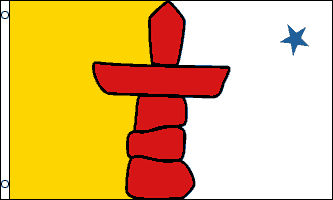 |
|
Proportion: 1:2
History: Granted by Governor General Roméo LeBlanc April 1, 1999. In 1993, legislation was passed to establish a new Northern Territory called Nunavut, which consists of the eastern part of the Northwest Territories.
Motto: Nunavut Sanginivut – Nunavut, our strength.
|
Description: The Flag of Nunavut consists of a yellow vertical left half and a white vertical right half. In the center is a man made stone symbol called an Inukshuk, and there is a blue, five pointed star on the right side.
Meaning: The Canadian government states: symbolizing the riches of the land and sky are the colors blue and gold. Red is a reference to Canada. The Inukshuk symbolizes the stone monuments which guide the people on the land and mark sacred and other special places. The Inukshuk is a man-like stone figure. The North Star, Nitirqsuituq, is the traditional guide for navigation, still used today. Nunavut is an Inuktitut word meaning "Our Land".
|
|
|
|
ONTARIO
|
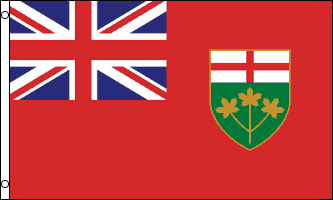 |
|
Proportion: 1:2
History: Act of Legislature assented to April 14, 1965. Queen Elizabeth II's approval of use of Royal Union Flag given on May 11, 1965. Flag raised on May 21, 1965.
Motto: Ut Incepit Fidelis Sic Permanent -
Loyal She Began, Loyal She Remains. |
Description: The Flag of Ontario consists of a red base with a British Union Jack in the top left quarter and the shield from the provincial coat of arms on the right side.
Meaning: The shield on the Ontario Flag features the cross of Saint George, which represents England, and three maple leaves, which represent Canada.
|
|
|
|
PRINCE EDWARD ISLAND
|
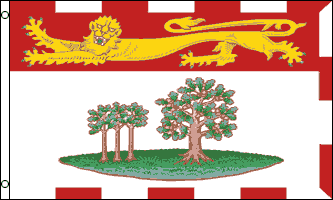 |
|
Proportion: 2:3
History: Royal Warrant of King Edward VII, May 30, 1905 assigning Arms and Banner. Act of Legislature assented to and adopted on March 24, 1964. Prince Edward Island joined the Confederation of Canada on July 1, 1873. The coat of arms was adopted in 1905.
|
Motto: Parva Sub Ingenti - The Small Under the Protection of the Great
Description: The Flag of Prince Edward Island consists of a golden lion on a red base in the upper third of the Flag. It has three small oak trees clustered together next to one large oak tree, on a white base, in the bottom section. The Flag is bordered in red and white except for the left side. The Flag is a replication of the provincial coat of arms.
Meaning: The British lion represents Prince Edward Island's links with Britain. The three small oak trees represent Princes, Queens and Kings. The three counties of Prince Edward Island and the large oak tree stand for Canada and Britain.
|
|
|
|
QUEBEC
|
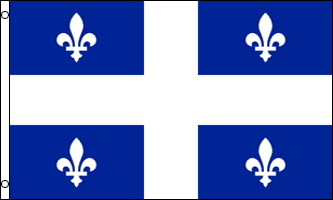 |
|
Proportion: 2:3
History: Order of the Lieutenant Governor in Council, January 21, 1948.
Flag raised on January 21, 1948. Act of Legislature assented to March 9, 1950. Quebec joined the Confederation of Canada on July 1, 1867.
Motto: Je Me Souviens – I Remember.
|
Description: The Flag of Quebec consists of a blue base with a white cross through the center, dividing the Flag into quarters. In each quarter there is a white Fleur–de–lys (also spelled fleur de lis).
Meaning: The Flag of Quebec is often called the "Fleur–de–lis" Flag. The white cross originates from ancient royal Flags of France. Contrary to popular belief, the Fleurs-de-lis are not taken from the banners of French kings, who used golden Fleurs-de-lis. The white Ffleurs–de–lis, on Quebec´s Flag, are symbols of purity; which originally represented the Virgin Mary. The name Quebec originates from an Algonquin word for narrow passage. It originally referred to point of the St. Lawrence River where it narrows near what is now Quebec City. In 1763, the British named their newly captured colony Quebec.
|
|
|
|
SASKATCHEWAN
|
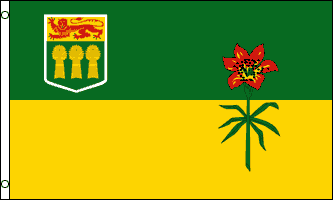 |
|
Proportion: 1:2
History: Act of Legislature assented to March 31, 1969. Proclaimed by the Lieutenant Governor on September 22, 1969. The Flag was adopted on Mar. 1, 1969. Saskatchewan joined the confederation of Canada on Sept. 1, 1905. The coat of arms was granted by Royal warrant in 1906 and was modified in 1986.
|
Motto: Multis E Gentibus Vires - From Many Peoples Strength.
Description: The Flag of Saskatchewan consists of two horizontal halves. The top half is green and the bottom is gold. The provincial shield of arms is in the upper left side and the western red lily, which is the provincial flower, is on the right side of the Flag.
Meaning: The top of the shield features a red lion, a traditional royal symbol, on a horizontal gold stripe. The bottom section has three gold wheat sheaves on a green base. This represents Saskatchewan's agriculture and resources. The green half represents the northern forested areas of Saskatchewan and the gold half symbolizes the southern grain fields.
|
|
|
|
YUKON
|
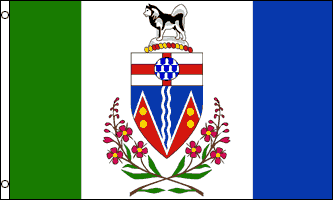 |
|
Proportion: 1:2
History: The Flag was adopted on Dec. 1, 1967. The coat of arms was adopted in 1956. The Yukon Territory joined the confederation of Canada on June 13, 1898.
Motto: The Yukon has no official motto.
|
Description: The Flag of the Yukon Territory consists of three vertical stripes. The left stripe is green, the middle white and the right strip is blue. The Yukon coat of arms is in the center of the white stripe and Flag. Below the arms is a wreath of fireweed, which is the Yukon's official flower.
Meaning: The blue stripe symbolizes the Yukon's rivers and lakes and the green symbolizes the territory's forests. The white stripe represents snow. The coat of arms contains the cross of Saint George, representing England. In the centre of the cross is a circle representing the fur trade. The red triangles with gold circles stand for the Yukon's mineral rich mountains. The wavy lines symbolize the Territory's rivers and the Alaskan malamute dog is an important part of the Yukon's history. The Yukon is named after the Yukon River, which runs through the territory.
|
|
|
|


